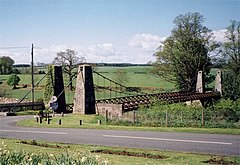Kalemouth Suspension Bridge
| Kalemouth Suspension Bridge | |
| Roxburghshire | |
|---|---|
 The Kalemouth Suspension Bridge | |
| Location | |
| Carrying: | Minor lane |
| Crossing: | River Teviot |
| Location | |
| Grid reference: | NT708274 |
| Location: | 55°32’24"N, 2°27’49"W |
| Structure | |
| Main span: | 180 feet |
| Material: | Wrought iron |
| History | |
| Built 1820s | |
| Architect: | Captain Samuel Brown |
| Information | |
The Kalemouth Suspension Bridge is a suspension bridge at Kalemouth in Roxburghshire, near the B6401. It crosses the River Teviot just above the point where the Kale Water joins it, near Eckford.
History
The bridge was designed by Captain Samuel Brown (1776-1852), an officer of the Royal Navy, and built by William Mather, a contractor of Kalemouth, some time between 1820 and 1830.[1] Alexander Jeffrey wrote in 1838 "there is a chain bridge erected over the Tweed (sic) by the Late Mr Ormiston of that Ilk, at his own expense, for his private use: but it has since been opened to the public for a trifling fee - a boon which cannot easily be forgot or misused."[2] In 1834, the tolls were ½d. for a foot passenger, 3d. for a horse or cart, 6d. for a gig, and 1s. for a chaise.[3] Tolls are thought to have been paid at Kalemouth Cottage, now enlarged and a private home.[1][2]
Today the bridge is protected as a Category A listed building.
The bridge is still in use as a public road bridge carrying an unclassified road. It is one of the earliest surviving carriage suspension bridges.
Design
The bridge crosses the River Teviot just above the Kale Water near Eckford.[4] There is another nearby bridge called the Kalemouth Bridge, which carries the A698 over the Kale Water.[5]
The bridge works on the principle of suspension, and uses chains with long iron links for the suspension cables. Iron rods are used for suspenders to connect the chain to the deck of the bridge, and additional suspenders have been added in the middle of the chain links.[1] A red painted wooden truss supports the wooden deck, which is covered with a layer of asphalt.[1] The four ashlar pylons at the ends of the bridge are of pyramidal form.[1]
The bridge has a span of 180 feet, and is 16 feet wide.[3]
Outside links
| ("Wikimedia Commons" has material about Kalemouth Suspension Bridge) |
References
- ↑ 1.0 1.1 1.2 1.3 1.4 "Kalemouth Suspension Bridge". scotlandsplaces.gov.uk. http://www.scotlandsplaces.gov.uk/record/rcahms/58251/kalemouth-suspension-bridge/rcahms?item=494378. Retrieved 8 September 2014.
- ↑ 2.0 2.1 "Kalemouth Bridge". eckford.org.uk. http://eckford.org.uk/history/kalemouth_bridge. Retrieved 9 September 2014.
- ↑ 3.0 3.1 The new statistical account of Scotland. Blackwood. 1837. p. 232. https://books.google.com/books?id=f6I_AAAAcAAJ&pg=RA1-PA232.
- ↑ "Overview of Kalemouth Suspension Bridge". Gazeteer for Scotland. http://www.scottish-places.info/features/featurefirst11350.html. Retrieved 8 September 2014.
- ↑ CANMORE (RCAHMS) record of Kalemouth Bridge
